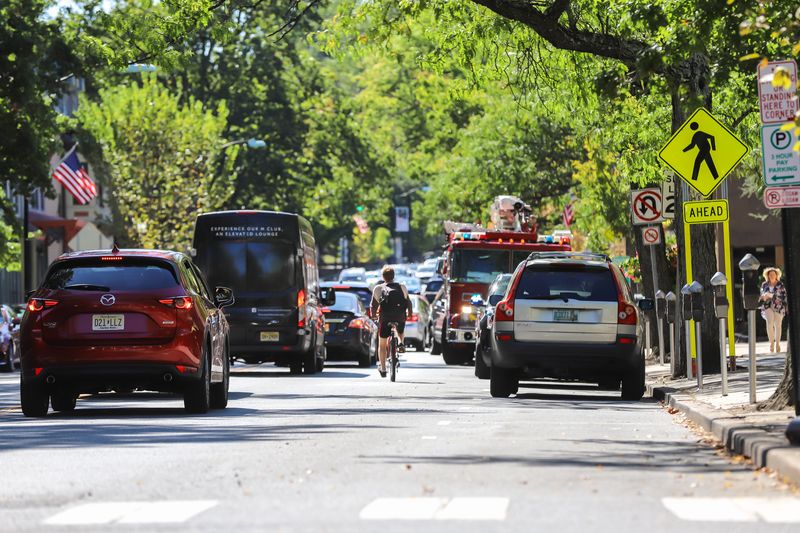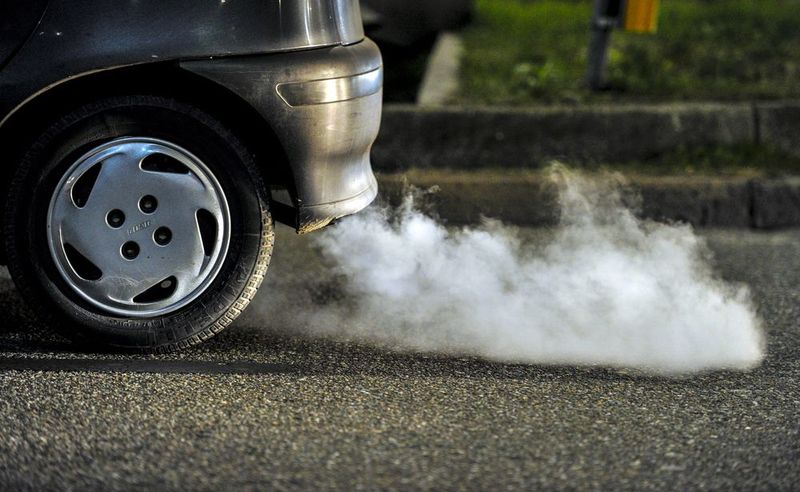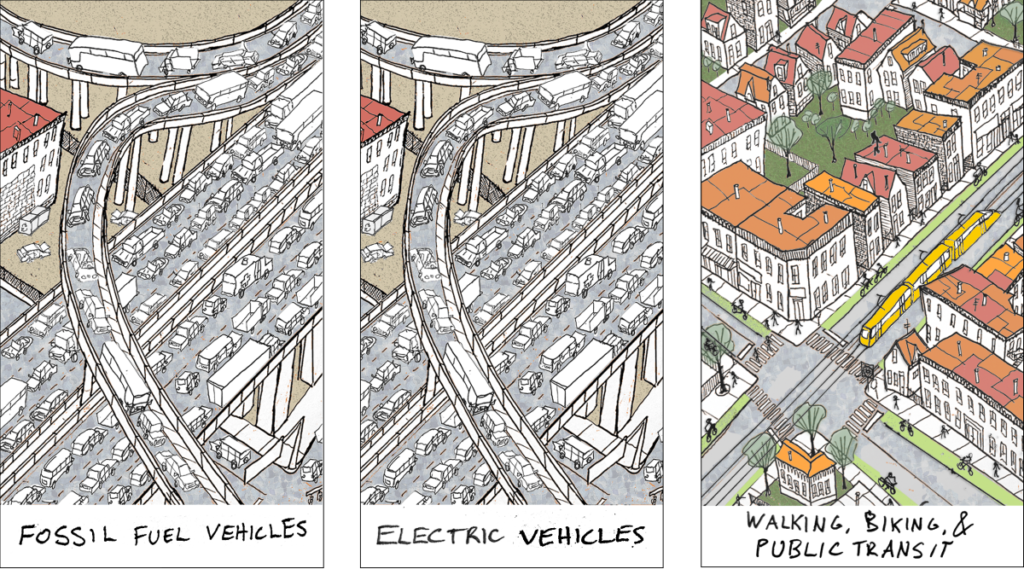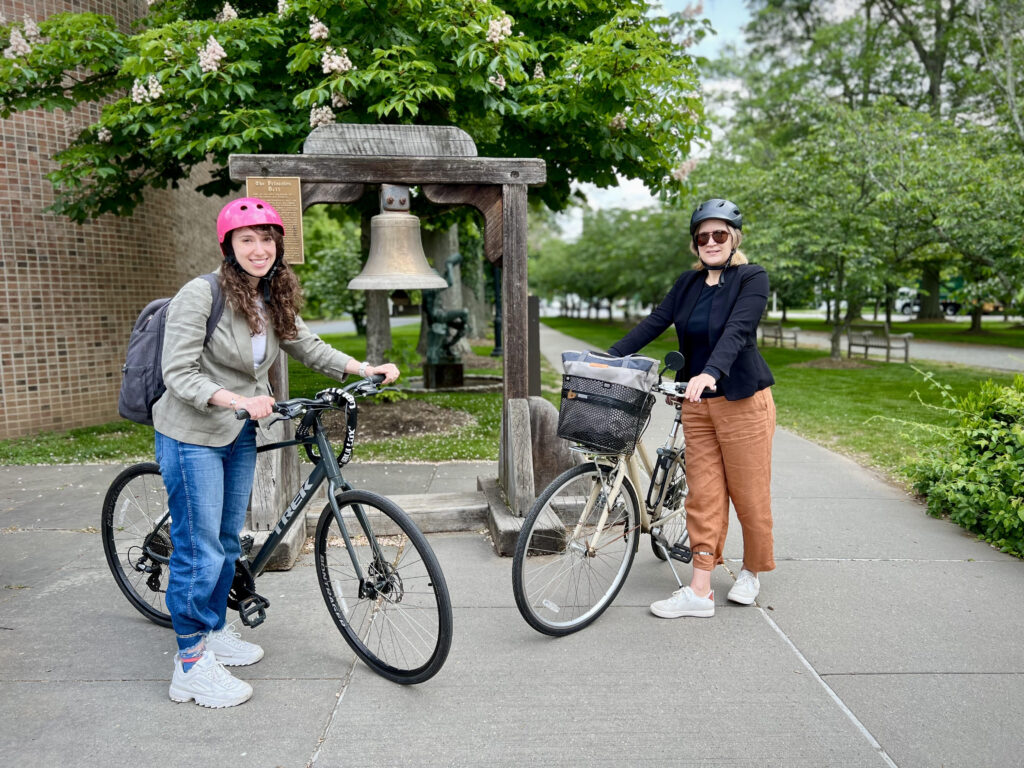Welcome to our explainer series, taking important topics and going deeper!
What is car dependency?
Car dependency means relying on cars as the main way to get around because of how cities and transportation systems are built. In the United States, this is often the norm. In 2021, 91.7% of American households owned at least one car.1 Most workers—68%—drive alone to work,2 and 80% of people feel they have no other option but to use a car.3
This system developed because of things like building highways after World War II, requiring lots of parking spaces in new developments, not adding enough sidewalks or bike lanes, and spending less on buses and trains. As a result, cars became the easiest or only way to travel, even in somewhat walkable places like Princeton.

How did it happen?
When cars were introduced in the 20th century, there was a deliberate push to make them the main form of transportation. Car manufacturers, dealers, and automotive clubs worked together to promote cars and build a society that relied on them. This effort helped cars become popular in the U.S. faster than in many other countries. As cars became more common, new standards for infrastructure—like bridges, tunnels, traffic signals, and parking—were quickly adopted to support them.
In the 1950s, the construction of the interstate highway system cut through many cities, further reinforcing car travel. At the same time, a broader culture developed around the idea that cars were the best or only option for getting around. Policies mostly focused on improving cars and keeping people driving, while in some European countries, efforts also included encouraging alternatives. These included measures like lowering speed limits, reducing parking, and creating car-free zones to make other forms of transportation more appealing.

Why is it an issue?
Car dependency creates significant environmental, health, financial, and social challenges. Transportation is the largest source of greenhouse gas emissions in the United States and the second-largest in Princeton, after buildings. Noise and air pollution from cars are linked to health problems like heart disease and asthma, particularly for those living near major roadways. Stress, high blood pressure, and decreased physical activity are common side effects of a car-dependent lifestyle.
Financially, cars are one of the largest household expenses after housing and healthcare. And the costs for vehicles, fuel, insurance, and maintenance have been rising steadily. These expenses disproportionately impact communities of color and lower-income households, who also bear the brunt of climate change. A more compassionate and inclusive society begins with recognizing this disparity and prioritizing their transportation needs.
Socially, car dependency limits freedom and connections. People who cannot drive—due to age, disability, or cost—face significant barriers, while those who can drive often sacrifice their limited free time to long commutes or errands. Car dependency also reduces opportunities for community interaction, especially in areas without walkable spaces or public transit. Safety is another concern, with an estimated 42,195 people dying in car crashes in 2021—the highest number since 2005.4 Pedestrian and cyclist fatalities are also on the rise.
Although switching to electric cars can help lower emissions, it doesn’t address the deeper issues of car dependency or the assumption that cars should be the default mode of transportation. A more inclusive and sustainable approach is needed to create a transportation system that works for everyone.
Relying so much on cars can be expensive and affect health, social connections, and the environment. However, solutions exist, like making neighborhoods easier to walk in, adding safer routes for bikes and pedestrians, and improving public transportation. Changing how we get around might seem like a big task, but history shows that major shifts—like when cars first became popular—are possible.

Driving is encouraged and subsidized
Driving continues to be heavily supported through government spending and policies. Some argue that building public transit or pedestrian-friendly infrastructure is too expensive, but maintaining highways and roads for all the cars already on the road also requires significant resources. For example, in 2019, the federal government spent $46 billion on highways. By 2023, 44% of transportation spending went to highways, while only 22% supported mass transit and rail.
Compared to Europe, taxes on car ownership and use are lower in the U.S., and gas taxes here often go directly toward building and maintaining roads. In Europe, these taxes usually go into the country’s general fund, benefiting broader public needs. In the U.S., gas taxes, tolls, and registration fees don’t cover the full cost of road maintenance. Instead, property, income, and other unrelated taxes help fill the gap, which keeps driving costs lower for individuals and increases demand.6
What can you do?
There are solutions available. Encouraging more people to walk, bike, and use public transit will improve health and reduce emissions and pollution right away. Making these options safe, affordable, and accessible can be achieved through policy changes and better infrastructure. We should also focus on electrifying public transit, getting rid of gas-powered cars, and expanding EV charging stations while making electric vehicles more affordable.
This will take time, but it’s possible and will lead to long-term improvements. Solving this issue requires significant changes, which can only happen through collective effort. Keep making a difference in your community and get involved however you can!
Relying so much on cars can be expensive and affect health, social connections, and the environment. However, solutions exist, like making neighborhoods easier to walk in, adding safer routes for bikes and pedestrians, and improving public transportation. Changing how we get around might seem like a big task, but history shows that major shifts—like when cars first became popular—are possible.

Want to learn more?
We will be sharing our explainers every month. If there are topics you’d like to know more about, please email info@sustainableprinceton.org.
- https://data.census.gov/table/ACSDP5Y2021.DP04?hidePreview=true ↩︎
- https://www.census.gov/newsroom/press-releases/2022/people-working-from-home.html ↩︎
- https://www.filesforprogress.org/memos/gnd-for-transit-polling.pdf ↩︎
- https://www.nhtsa.gov/press-releases/early-estimate-2021-traffic-fatalities ↩︎
- https://yaleclimateconnections.org/2023/10/american-society-wasnt-always-so-car-centric-our-future-doesnt-have-to-be-either/ ↩︎
- https://www.bloomberg.com/news/articles/2014-02-04/9-reasons-the-u-s-ended-up-so-much-more-car-dependent-than-europe ↩︎


